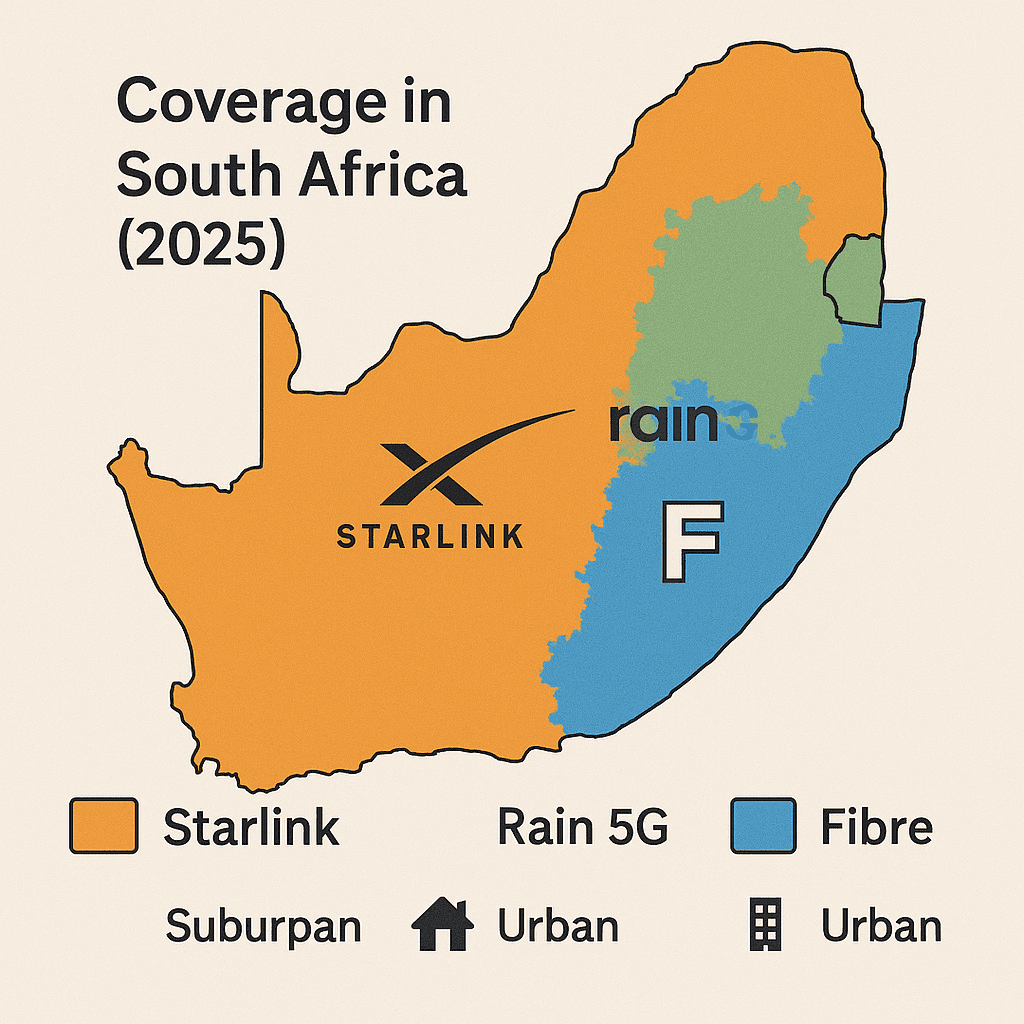Best Internet Provider South Africa 2025

Best Internet Provider South Africa 2025
Choosing the best internet provider in South Africa in 2025 isn’t just about raw speed anymore. It’s about finding reliable connectivity that keeps working during power outages, fits comfortably within your budget, and actually reaches your home or business. With Starlink’s satellite technology increasingly accessible via local importers, Rain’s rapidly expanding 5G network, and traditional fibre infrastructure reaching more areas, South African consumers have more choices than ever before.
Whether you’re a remote worker in Mpumalanga needing a stable connection, a gamer in Cape Town demanding low lag, or running a small business in Johannesburg where uptime is everything, this complete guide will help you navigate the often-complex world of internet providers in South Africa and make the smart choice for your specific needs and wallet.
South Africa’s Internet Scene in 2025
The South African internet market has changed a lot over the last couple of years. Starlink in South Africa, though generally operating through local importers because of ongoing licensing processes with ICASA, has opened up high-speed possibilities, especially in places without other options. At the same time, Rain 5G South Africa has grown its reach beyond the main cities, and well-known fibre providers like Vuma and Openserve continue to lay down their cables in new suburbs and even townships.
Understanding Your Internet Options: Satellite, 5G, Fibre, and LTE
Each internet technology serves different needs across our varied country:
- Satellite internet (mainly Starlink) is fantastic for remote areas where laying traditional cables just isn’t practical.
- 5G offers quick speeds often without needing a lengthy installation process, making it great for apartment living or immediate use.
- Fibre internet in South Africa remains the top choice for consistent, very fast connections directly to your home or office.
- LTE (often mobile data) works well as an affordable, flexible backup or for lighter use.
The Load-Shedding Factor: Keeping You Online
The ongoing power cuts have become a really important point when picking an internet provider.
- Fibre connections usually have battery backups at the street-level cabinets (like the small boxes on poles or sidewalks), which can keep your service running for 4-6 hours during outages.
- Starlink requires its own separate battery or power solution at your location.
- Rain’s 5G routers are generally designed to run on a power bank, making them quite popular for staying online during longer outages.
- LTE routers also use relatively little power and can often run on power banks.
Speed and Performance: How Providers Compare
Here’s a quick look at how the main internet providers in South Africa stack up in terms of real-world performance:
| Provider Type | Download Speed | Upload Speed | Latency | Load-shedding Resilience |
| Starlink | 50-200 Mbps | 15-25 Mbps | 100-300ms | Requires backup power |
| Rain 5G | 25-150 Mbps | 10-40 Mbps | 30-80ms | Good (power bank compatible) |
| Fibre | 20-500 Mbps | 20-200 Mbps | 10-40ms | Excellent (built-in backup) |
| LTE | 10-100 Mbps | 5-20 Mbps | 50-100ms | Good (low power use) |
Export to Sheets
Download/Upload Speed Analysis: Based on recent 2025 speed tests from sources like MyBroadband, fibre consistently delivers the most stable and reliable speeds. For instance, a 100 Mbps fibre line typically hits its advertised speeds even during busy times. Rain 5G performance can differ quite a bit depending on your exact location, offering great speeds in well-covered spots but potentially slower performance in fringe areas.
Latency for Different Uses: For activities like online gaming and video calls, how quickly your signal travels (latency) matters more than just raw speed. Fibre’s low latency (10-40ms) makes it perfect for competitive gaming or smooth, real-time online meetings. Starlink’s latency, while getting better, can still cause noticeable delays in these types of real-time applications.
Internet Provider Costs in South Africa
Understanding the price is key. Here’s a look at typical monthly costs for uncapped internet in 2025:
- Starlink: Around R1,799/month (plus a higher upfront equipment cost of R12,000-R15,000).
- Rain 5G Premium: Typically R799/month (equipment usually included).
- Fibre 100 Mbps: Ranges from R699-R999/month (initial installation often around R999, but frequently waived by providers).
- LTE Uncapped: Varies from R699-R1,199/month (upfront equipment cost of R1,000-R1,500).
Hidden Costs and Installation Fees
Many people overlook the initial installation and equipment costs. While Rain generally includes the necessary equipment and doesn’t charge for installation, fibre setups can take 4-8 weeks to complete and might involve extra costs for complex installations in certain buildings or estates. Starlink’s upfront equipment cost remains the biggest hurdle for new users.
Value for Money
When you calculate the overall cost over, say, 24 months, fibre generally offers the best value per megabit in areas where it’s available. Rain 5G comes in next. Starlink’s higher price is really only justified if you’re in an area where no other good internet options exist.
Coverage and Availability Across SA
Urban vs. Rural Access
Fibre internet in South Africa coverage is still mainly found in cities and larger towns, with roughly 40% of South African homes currently having access. Rain’s 5G network reaches about 60% of the population, but its strongest signals are in business hubs and densely populated areas.
Provincial Coverage Maps
Provinces like Gauteng and the Western Cape usually have the most choices, with many fibre providers and wide 5G coverage. More rural provinces such as Limpopo and the Eastern Cape often rely more heavily on LTE, and increasingly on Starlink, for their faster internet needs.
Future Expansion Plans
Looking ahead, Vuma plans to connect an additional 500,000 homes by the end of 2025. Rain is also expanding its 5G network to 50 more towns. A full ICASA licensing approval for Starlink could potentially lead to better pricing and wider, more direct availability in the future.
Best Internet Provider by How You Use It
Your ideal choice depends on your daily internet habits.
For Remote Workers and Digital Nomads
For smooth video conferencing and reliable cloud access, fibre remains the top pick where available. In areas without fibre, Rain 5G South Africa offers great flexibility and strong performance for work on the go. Starlink is a solid choice for truly remote locations, but remember to factor in battery backup solutions.
For Gamers and Streamers
Serious gamers absolutely need fibre’s low latency for competitive online play. Content creators and streamers also greatly benefit from fibre’s superior upload speeds—a 200 Mbps fibre line often provides 100 Mbps upload, which is vital for live streaming and uploading large video files.
For Small Businesses and Home Offices
Ensuring continuous business operations during power cuts makes fibre very appealing. However, Rain 5G’s quick setup and adaptability often make it a strong contender for small businesses needing immediate connectivity. Many businesses now use a combination: fibre as their main connection, with Rain or LTE as a reliable backup during outages.
For Budget-Conscious Users
Rain’s starting 5G packages offer real value, especially since they typically include equipment and have no installation fees or long-term contracts. LTE remains the most affordable for light internet users, but be aware that fair usage policies and potential speed reductions might limit heavy data consumption.
Making Your Final Decision
Choosing the best internet provider in South Africa ultimately comes down to your specific location, your budget, and how you use the internet every day.
- Urban users with fibre access should generally make it their first choice for its speed and consistent reliability.
- Rain 5G stands out for its flexibility and quick setup.
- Starlink is a game-changer for rural connectivity, though it comes at a higher price.
For many South African professionals and households, a mixed approach often works best: a primary fibre or Rain 5G connection, supported by an LTE backup for added resilience during power outages. Before you make your final decision, make sure to check detailed coverage maps, read recent user reviews, and, importantly, consider your specific load-shedding backup needs.
Ready to upgrade your internet? Start by checking availability in your area directly through provider websites. Compare actual speeds using local speed test tools, and remember to think about the load-shedding backup solutions for your specific setup.




